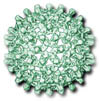 |
|
|
Disease information Information brève en Français
Hepatitis B Hepatitis B virus is spread from infected mothers to their infants at birth, between young children, through contaminated blood, unsafe injections and sex. An estimated 350 million people are chronic carriers of the virus, which kills about 521,000 people a year. Although most people are infected in infancy or childhood, most deaths from hepatitis B are in adulthood, as a result of cirrhosis and/or liver cancer, both of which are strongly associated with the virus. Vaccines against hepatitis B have been available for 18 years. Their impact is already being seen in reduced numbers of adult deaths from liver cancer in countries where the vaccine is used routinely in infants. However, even at a cost of $0.50 for each of the three doses needed, this vaccine is beyond the reach of many countries. By the time today's infants reach childhood, an increase in the size of the global adult population will increase the number of deaths related to hepatitis B to around 1.8 million a year. Vaccines against hepatitis B are made from purified forms of the protein coat of the virus. They are safe and, when used properly, highly effective. For more information see
|
At a glance Vaccine-preventable disease statistics Glossaire des infections a prévention vaccinale 'Traditional' or 'basic' vaccines
Under-used vaccines
Vaccines that are expected to be available shortly
Other vaccines
Vaccines for which more research is needed
|
||||||
|
|
|
Copyright © GAVI |
